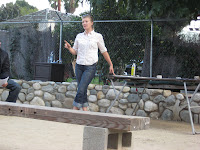This past weekend, I attended a composting workshop at the Milagro Allegro community garden in Highland Park, which was taught by master gardener Lora Hall. Having no previous experience in composting myself, I sat through the hour-long lecture with an expression of awe and fear.
Apparently, there are 3 main types of composting: cold, hot, and worm (yes worm, not warm!).
Cold composting is probably the most basic. It entails digging a hole in your garden, adding organic material, and covering the pile with dirt and wood chips. After a really long time, it's ready to dig up and voila!, compost. This process seems great if you have plenty of space, tons of time and are seriously lazy.
Hot composting is the quickest method and is great for large volumes of food waste and yard scraps. It also supposedly creates a large amount of favorable, disease-suppressing microbes. This process consists of creating large piles of organic material with specific carbon/nitrogen ratios, which at first seems kinda scary, but isn't really. A very detailed description of setting up this method can be found here.
Worm composting (or vermicomposting) is ideal for urban apartments and small spaces. It is also great if you just have food scraps (and no yard scraps) that you want to recycle. This is what a commercial worm composting bin looks like:
If you want to make your own bin, check out this Martha Stewart episode.
To start a worm composting system, add some moist bedding (shredded newspaper or coconut coir), throw in a few hundred red wiggler worms, bury some food, and then wait for two months. Note: Make sure to store your worm bin in a shady place, or your worms will die from heat stroke. There's so much more to say, but I'm getting tired. Check out The Worm Book for everything you ever wanted to know about worm composting. More details to come in the future! -E



No comments:
Post a Comment